Hik33 蓝藻 信号调节
- 格式:pdf
- 大小:4.48 MB
- 文档页数:11
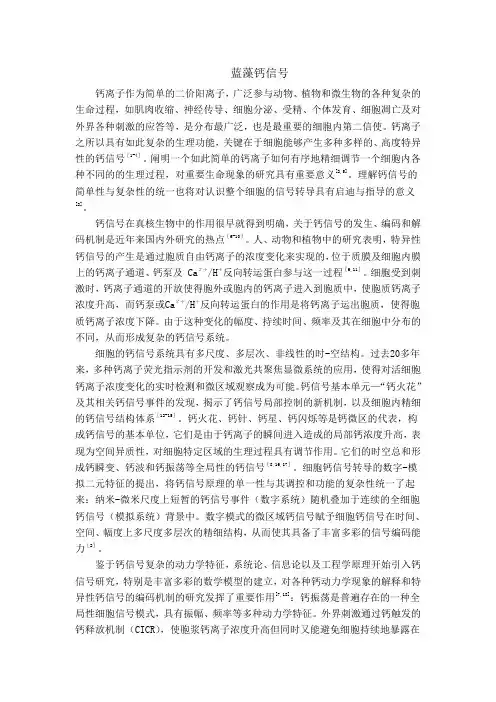
蓝藻钙信号钙离子作为简单的二价阳离子,广泛参与动物、植物和微生物的各种复杂的生命过程,如肌肉收缩、神经传导、细胞分泌、受精、个体发育、细胞凋亡及对外界各种刺激的应答等,是分布最广泛,也是最重要的细胞内第二信使。
钙离子之所以具有如此复杂的生理功能,关键在于细胞能够产生多种多样的、高度特异性的钙信号[1-4]。
阐明一个如此简单的钙离子如何有序地精细调节一个细胞内各种不同的的生理过程,对重要生命现象的研究具有重要意义[2,5]。
理解钙信号的简单性与复杂性的统一也将对认识整个细胞的信号转导具有启迪与指导的意义[2]。
钙信号在真核生物中的作用很早就得到明确,关于钙信号的发生、编码和解码机制是近年来国内外研究的热点[6-10]。
人、动物和植物中的研究表明,特异性钙信号的产生是通过胞质自由钙离子的浓度变化来实现的,位于质膜及细胞内膜上的钙离子通道、钙泵及 Ca2+/H+反向转运蛋白参与这一过程[6,11]。
细胞受到刺激时,钙离子通道的开放使得胞外或胞内的钙离子进入到胞质中,使胞质钙离子浓度升高,而钙泵或Ca2+/H+反向转运蛋白的作用是将钙离子运出胞质,使得胞质钙离子浓度下降。
由于这种变化的幅度、持续时间、频率及其在细胞中分布的不同,从而形成复杂的钙信号系统。
细胞的钙信号系统具有多尺度、多层次、非线性的时-空结构。
过去20多年来,多种钙离子荧光指示剂的开发和激光共聚焦显微系统的应用,使得对活细胞钙离子浓度变化的实时检测和微区域观察成为可能。
钙信号基本单元—“钙火花”及其相关钙信号事件的发现,揭示了钙信号局部控制的新机制,以及细胞内精细的钙信号结构体系[12-15]。
钙火花、钙针、钙星、钙闪烁等是钙微区的代表,构成钙信号的基本单位,它们是由于钙离子的瞬间进入造成的局部钙浓度升高,表现为空间异质性,对细胞特定区域的生理过程具有调节作用。
它们的时空总和形成钙瞬变、钙波和钙振荡等全局性的钙信号[8,16,17]。
细胞钙信号转导的数字-模拟二元特征的提出,将钙信号原理的单一性与其调控和功能的复杂性统一了起来:纳米-微米尺度上短暂的钙信号事件(数字系统)随机叠加于连续的全细胞钙信号(模拟系统)背景中。
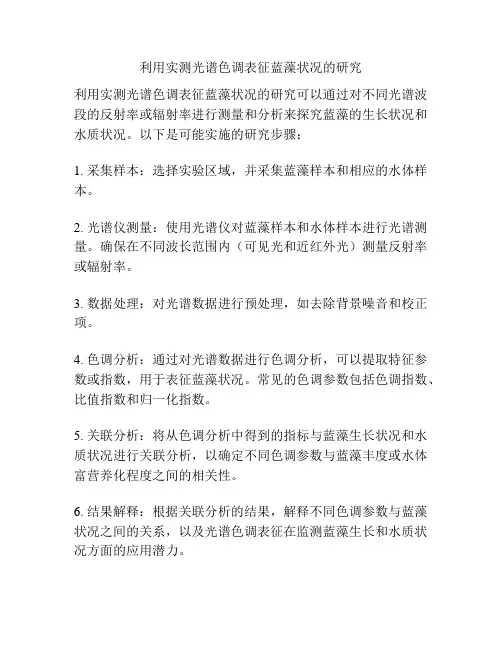
利用实测光谱色调表征蓝藻状况的研究
利用实测光谱色调表征蓝藻状况的研究可以通过对不同光谱波段的反射率或辐射率进行测量和分析来探究蓝藻的生长状况和水质状况。
以下是可能实施的研究步骤:
1. 采集样本:选择实验区域,并采集蓝藻样本和相应的水体样本。
2. 光谱仪测量:使用光谱仪对蓝藻样本和水体样本进行光谱测量。
确保在不同波长范围内(可见光和近红外光)测量反射率或辐射率。
3. 数据处理:对光谱数据进行预处理,如去除背景噪音和校正项。
4. 色调分析:通过对光谱数据进行色调分析,可以提取特征参数或指数,用于表征蓝藻状况。
常见的色调参数包括色调指数、比值指数和归一化指数。
5. 关联分析:将从色调分析中得到的指标与蓝藻生长状况和水质状况进行关联分析,以确定不同色调参数与蓝藻丰度或水体富营养化程度之间的相关性。
6. 结果解释:根据关联分析的结果,解释不同色调参数与蓝藻状况之间的关系,以及光谱色调表征在监测蓝藻生长和水质状况方面的应用潜力。
7. 结论和展望:总结研究的结果,提出对未来研究的展望,如开发更精确的色调指标或结合其他水质参数进行综合分析。
需要注意的是,这仅是一个基本的研究框架,实际研究还需要根据具体情况进行不同步骤的调整和优化。
此外,实施该研究需要使用专业的光谱设备和分析软件,并且需要对选取的色调参数进行验证和验证结果。
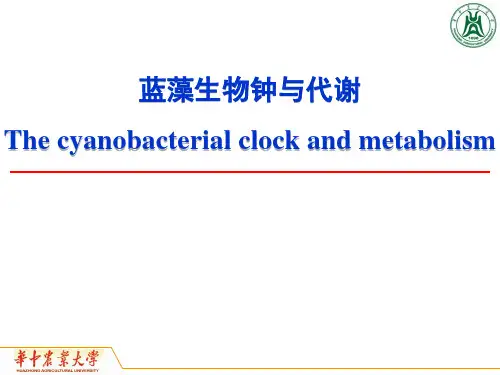
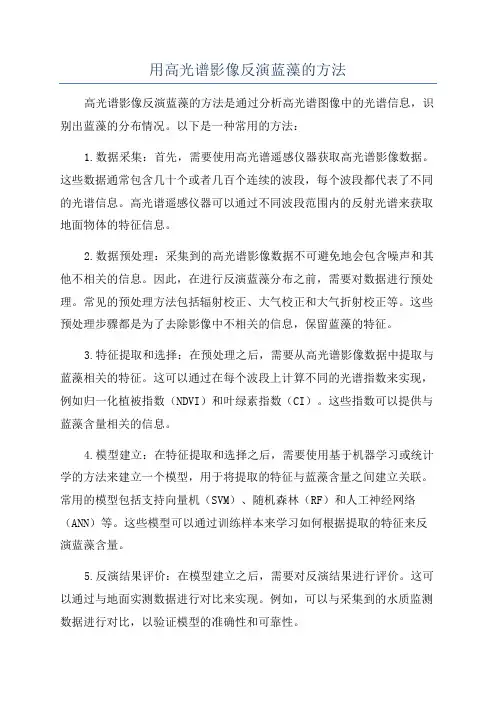
用高光谱影像反演蓝藻的方法高光谱影像反演蓝藻的方法是通过分析高光谱图像中的光谱信息,识别出蓝藻的分布情况。
以下是一种常用的方法:1.数据采集:首先,需要使用高光谱遥感仪器获取高光谱影像数据。
这些数据通常包含几十个或者几百个连续的波段,每个波段都代表了不同的光谱信息。
高光谱遥感仪器可以通过不同波段范围内的反射光谱来获取地面物体的特征信息。
2.数据预处理:采集到的高光谱影像数据不可避免地会包含噪声和其他不相关的信息。
因此,在进行反演蓝藻分布之前,需要对数据进行预处理。
常见的预处理方法包括辐射校正、大气校正和大气折射校正等。
这些预处理步骤都是为了去除影像中不相关的信息,保留蓝藻的特征。
3.特征提取和选择:在预处理之后,需要从高光谱影像数据中提取与蓝藻相关的特征。
这可以通过在每个波段上计算不同的光谱指数来实现,例如归一化植被指数(NDVI)和叶绿素指数(CI)。
这些指数可以提供与蓝藻含量相关的信息。
4.模型建立:在特征提取和选择之后,需要使用基于机器学习或统计学的方法来建立一个模型,用于将提取的特征与蓝藻含量之间建立关联。
常用的模型包括支持向量机(SVM)、随机森林(RF)和人工神经网络(ANN)等。
这些模型可以通过训练样本来学习如何根据提取的特征来反演蓝藻含量。
5.反演结果评价:在模型建立之后,需要对反演结果进行评价。
这可以通过与地面实测数据进行对比来实现。
例如,可以与采集到的水质监测数据进行对比,以验证模型的准确性和可靠性。
6.反演蓝藻分布:根据建立的模型和输入的高光谱影像数据,可以计算出整个区域内蓝藻的分布情况。
这些结果可以以图像或者栅格形式显示,以便于进一步的分析和研究。
需要注意的是,高光谱影像反演蓝藻的方法可以根据具体的研究目的和数据条件进行调整和改进。
此外,由于高光谱遥感数据的复杂性和处理过程的技术难度,反演蓝藻分布的结果可能会受到多种因素的干扰,因此在使用反演结果时需要谨慎分析和解释。
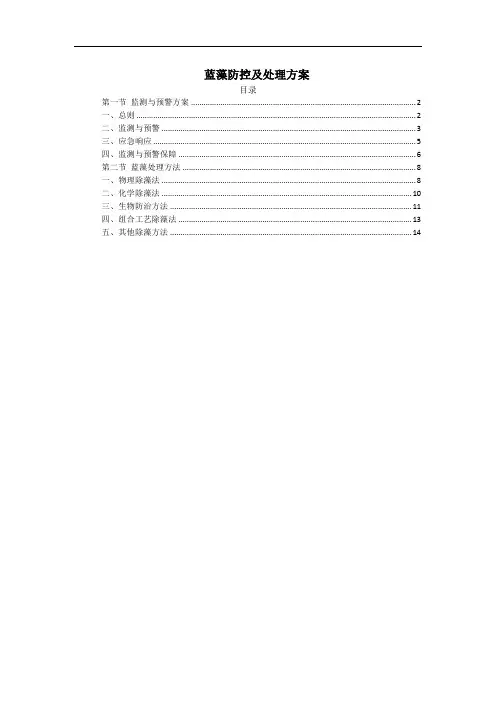
蓝藻防控及处理方案目录第一节监测与预警方案 (2)一、总则 (2)二、监测与预警 (3)三、应急响应 (5)四、监测与预警保障 (6)第二节蓝藻处理方法 (8)一、物理除藻法 (8)二、化学除藻法 (10)三、生物防治方法 (11)四、组合工艺除藻法 (13)五、其他除藻方法 (14)第一节监测与预警方案我司在做好打捞工作的同时,设计了一套关于蓝藻的监测与预警方案,力求将蓝藻水华的爆发扼杀在摇篮里,提高我司的服务效率与质量。
一、总则(一)编制目的为有效保护区域湖面的生态环境,防止蓝藻大面积、高密度疯长而引起水源水质恶化,降低蓝藻死亡后产生的有害物质对水体造成污染,确保蓝藻打捞有力有效,确保不因蓝藻暴发而导致水体发黑发臭,根据关规定,结合当地实际,特制定本预案。
(二)适用范围。
本预案适用于区域湖区的监测和预警(三)工作原则1.以人为本,预防为主。
把防控蓝藻大暴发作为我公司提供蓝藻打捞及资源化利用服务中的一项重要内容。
2.综合治理,统筹兼顾。
立足当前、着眼长远,统筹兼顾、多管齐下,加大综合治理力度。
做好处理突发事件的思想、物资和技术准备,组织力量开展技术攻关,提高水污染防治工作水平。
3.分工负责,协调高效。
在负责人的统一领导下,分工负责、协调推进,密切配合、形成合力。
针对不同情况所造成的突发事件,分类管理,分级负责,确保高效有序运转。
充分发挥各部门的职能作用,实行分级响应。
4.蓝藻打捞工作坚持“全面覆盖,专业打捞,集中处理”的原则,建立健全“机械化打捞与人工打捞相结合、堆场堆放与资源化利用、无害化处理相结合、科学监测预警与应急应对相结合”的长效工作机制。
(五)应急预案关联。
本预案主要针对湖面蓝藻暴发时的应急响应和处置机制,一般情况下,湖面蓝藻暴发总是和其他类别的污染事故同时发生,应当具体分析,统筹应对,这时其它相关专业类别的应急预案和事发地相关应急预案必须同时启动。
二、监测与预警(一)监测与预靖结合定期监测和人工巡查等手段,建立立体监测体系,按照湖区的实际情况增设监测点位,及时识别可能爆发蓝藻水华的区域。
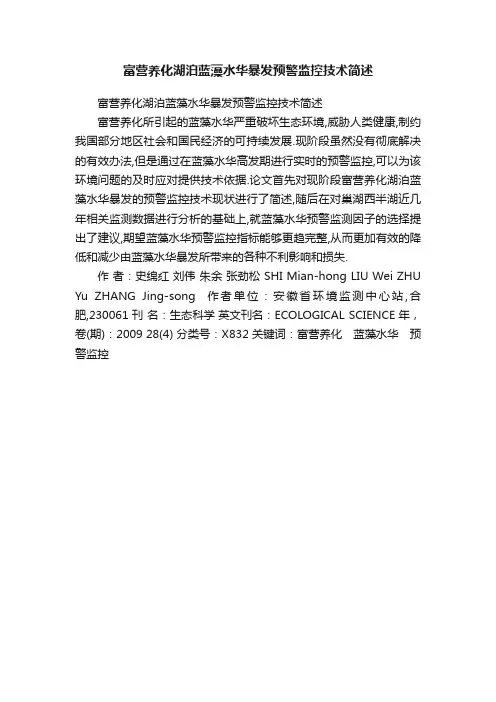
富营养化湖泊蓝藻水华暴发预警监控技术简述
富营养化湖泊蓝藻水华暴发预警监控技术简述
富营养化所引起的蓝藻水华严重破坏生态环境,威胁人类健康,制约我国部分地区社会和国民经济的可持续发展.现阶段虽然没有彻底解决的有效办法,但是通过在蓝藻水华高发期进行实时的预警监控,可以为该环境问题的及时应对提供技术依据.论文首先对现阶段富营养化湖泊蓝藻水华暴发的预警监控技术现状进行了简述,随后在对巢湖西半湖近几年相关监测数据进行分析的基础上,就蓝藻水华预警监测因子的选择提出了建议,期望蓝藻水华预警监控指标能够更趋完整,从而更加有效的降低和减少由蓝藻水华暴发所带来的各种不利影响和损失.
作者:史绵红刘伟朱余张劲松 SHI Mian-hong LIU Wei ZHU Yu ZHANG Jing-song 作者单位:安徽省环境监测中心站,合肥,230061 刊名:生态科学英文刊名:ECOLOGICAL SCIENCE 年,卷(期):2009 28(4) 分类号:X832 关键词:富营养化蓝藻水华预警监控。
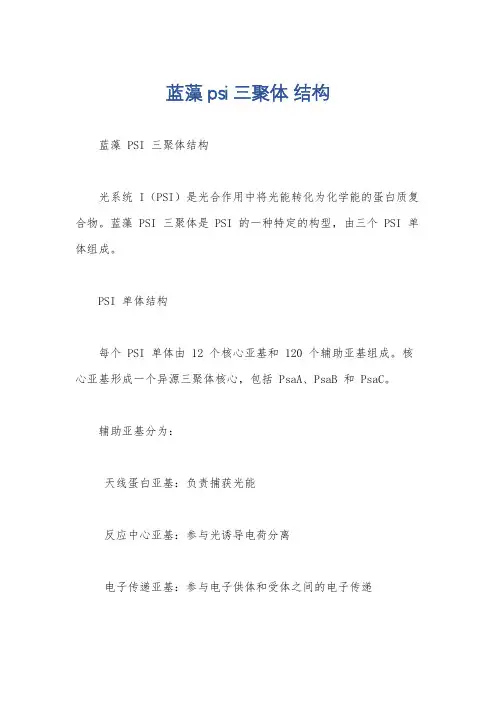
蓝藻psi三聚体结构蓝藻 PSI 三聚体结构光系统 I(PSI)是光合作用中将光能转化为化学能的蛋白质复合物。
蓝藻 PSI 三聚体是 PSI 的一种特定的构型,由三个 PSI 单体组成。
PSI 单体结构每个 PSI 单体由 12 个核心亚基和 120 个辅助亚基组成。
核心亚基形成一个异源三聚体核心,包括 PsaA、PsaB 和 PsaC。
辅助亚基分为:天线蛋白亚基:负责捕获光能反应中心亚基:参与光诱导电荷分离电子传递亚基:参与电子供体和受体之间的电子传递三聚体形成蓝藻 PSI 三聚体是由三个 PSI 单体的自组装形成的。
该组装过程受辅助亚基的相互作用的调节,特别是 PsaJ 和 PsaL 亚基之间的相互作用。
PsaJ 和 PsaL 亚基是两个大型跨膜螺旋蛋白,它们介导 PSI 单体之间的相互作用。
它们形成一个疏水性接口,将三个单体连接在一起。
三聚体的特点与 PSI 单体相比,PSI 三聚体具有以下特点:更大的天线尺寸:三聚体的三个天线蛋白复合物共同形成一个更大的光捕获面积,从而提高了光合效率。
增加的反应中心数量:每个三聚体有三个反应中心,可以同时捕获和转化光能。
更强的稳定性:三聚体结构比单体结构更稳定,因为它有更多的相互作用。
功能作用蓝藻 PSI 三聚体作为光合作用中的主要光捕获和能量转化装置,发挥着以下功能:光能捕获:天线蛋白复合物捕获光能并将其传递到反应中心。
电荷分离:反应中心利用光能将电子从叶绿素分子激发到电子传递链。
电子传递:电子通过电子传递亚基从反应中心传递到最终的电子受体。
质子泵送:PSI 的电子传递链与质子泵送相偶联,这有助于建立跨膜质子梯度。
环境适应蓝藻 PSI 三聚体的结构和功能可以适应不同的环境条件,例如光照强度和营养可用性。
例如,在低光照条件下,蓝藻可以增加PSI 三聚体的数量以捕获更多的光能。
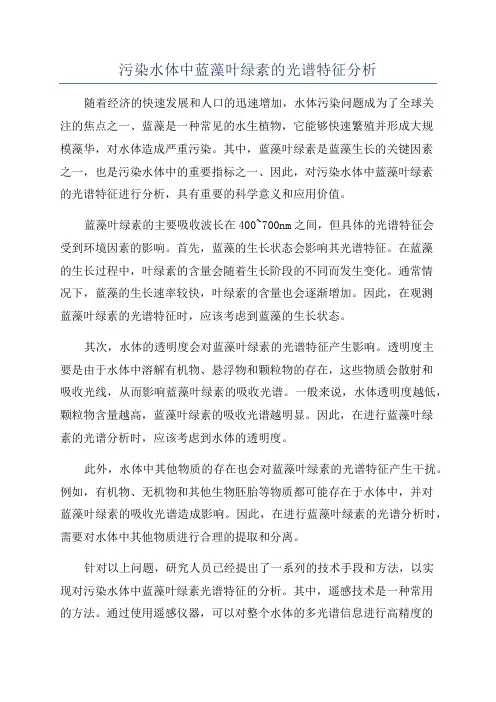
污染水体中蓝藻叶绿素的光谱特征分析随着经济的快速发展和人口的迅速增加,水体污染问题成为了全球关注的焦点之一、蓝藻是一种常见的水生植物,它能够快速繁殖并形成大规模藻华,对水体造成严重污染。
其中,蓝藻叶绿素是蓝藻生长的关键因素之一,也是污染水体中的重要指标之一、因此,对污染水体中蓝藻叶绿素的光谱特征进行分析,具有重要的科学意义和应用价值。
蓝藻叶绿素的主要吸收波长在400~700nm之间,但具体的光谱特征会受到环境因素的影响。
首先,蓝藻的生长状态会影响其光谱特征。
在蓝藻的生长过程中,叶绿素的含量会随着生长阶段的不同而发生变化。
通常情况下,蓝藻的生长速率较快,叶绿素的含量也会逐渐增加。
因此,在观测蓝藻叶绿素的光谱特征时,应该考虑到蓝藻的生长状态。
其次,水体的透明度会对蓝藻叶绿素的光谱特征产生影响。
透明度主要是由于水体中溶解有机物、悬浮物和颗粒物的存在,这些物质会散射和吸收光线,从而影响蓝藻叶绿素的吸收光谱。
一般来说,水体透明度越低,颗粒物含量越高,蓝藻叶绿素的吸收光谱越明显。
因此,在进行蓝藻叶绿素的光谱分析时,应该考虑到水体的透明度。
此外,水体中其他物质的存在也会对蓝藻叶绿素的光谱特征产生干扰。
例如,有机物、无机物和其他生物胚胎等物质都可能存在于水体中,并对蓝藻叶绿素的吸收光谱造成影响。
因此,在进行蓝藻叶绿素的光谱分析时,需要对水体中其他物质进行合理的提取和分离。
针对以上问题,研究人员已经提出了一系列的技术手段和方法,以实现对污染水体中蓝藻叶绿素光谱特征的分析。
其中,遥感技术是一种常用的方法。
通过使用遥感仪器,可以对整个水体的多光谱信息进行高精度的获取,并进一步提取蓝藻叶绿素的光谱特征。
此外,还可以使用光谱分析仪和光谱数据处理软件进行光谱曲线的提取和分析。
这些技术手段极大地促进了对污染水体中蓝藻叶绿素光谱特征的研究。
综上所述,污染水体中蓝藻叶绿素的光谱特征是环境科学研究中的重要问题之一、研究人员通过使用遥感技术、光谱分析仪和光谱数据处理软件等方法,可以对污染水体中蓝藻叶绿素的光谱特征进行分析,为水体污染治理提供科学依据和技术支持。
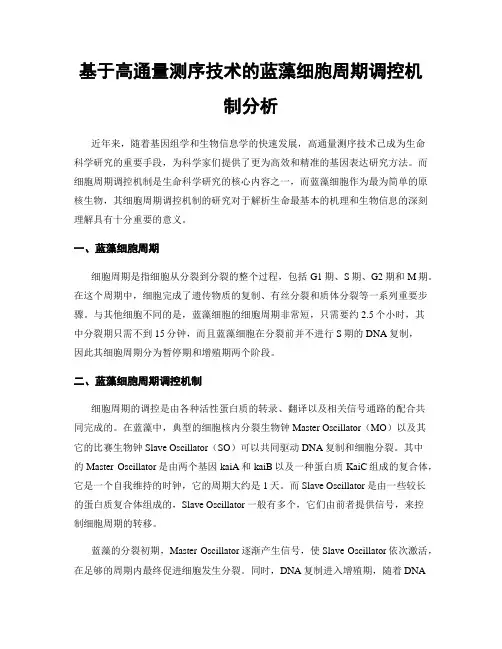
基于高通量测序技术的蓝藻细胞周期调控机制分析近年来,随着基因组学和生物信息学的快速发展,高通量测序技术已成为生命科学研究的重要手段,为科学家们提供了更为高效和精准的基因表达研究方法。
而细胞周期调控机制是生命科学研究的核心内容之一,而蓝藻细胞作为最为简单的原核生物,其细胞周期调控机制的研究对于解析生命最基本的机理和生物信息的深刻理解具有十分重要的意义。
一、蓝藻细胞周期细胞周期是指细胞从分裂到分裂的整个过程,包括G1期、S期、G2期和M期。
在这个周期中,细胞完成了遗传物质的复制、有丝分裂和质体分裂等一系列重要步骤。
与其他细胞不同的是,蓝藻细胞的细胞周期非常短,只需要约2.5个小时,其中分裂期只需不到15分钟,而且蓝藻细胞在分裂前并不进行S期的DNA复制,因此其细胞周期分为暂停期和增殖期两个阶段。
二、蓝藻细胞周期调控机制细胞周期的调控是由各种活性蛋白质的转录、翻译以及相关信号通路的配合共同完成的。
在蓝藻中,典型的细胞核内分裂生物钟Master Oscillator(MO)以及其它的比赛生物钟Slave Oscillator(SO)可以共同驱动DNA复制和细胞分裂。
其中的Master Oscillator是由两个基因kaiA和kaiB以及一种蛋白质KaiC组成的复合体,它是一个自我维持的时钟,它的周期大约是1天。
而Slave Oscillator是由一些较长的蛋白质复合体组成的,Slave Oscillator一般有多个,它们由前者提供信号,来控制细胞周期的转移。
蓝藻的分裂初期,Master Oscillator逐渐产生信号,使Slave Oscillator依次激活,在足够的周期内最终促进细胞发生分裂。
同时,DNA复制进入增殖期,随着DNA的复制完成和细胞大小的增加,蓝藻的细胞周期也开始终止,并开始降解细胞环内重要的蛋白质,如细胞分裂素(Cdc2)等。
在整个过程中,蓝藻细胞在约2.5小时内完成了1次完整的分裂过程,具有极高的生物学意义。
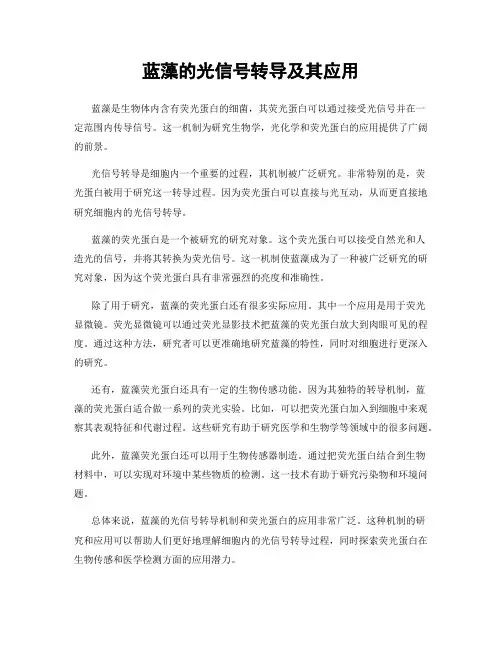
蓝藻的光信号转导及其应用蓝藻是生物体内含有荧光蛋白的细菌,其荧光蛋白可以通过接受光信号并在一定范围内传导信号。
这一机制为研究生物学,光化学和荧光蛋白的应用提供了广阔的前景。
光信号转导是细胞内一个重要的过程,其机制被广泛研究。
非常特别的是,荧光蛋白被用于研究这一转导过程。
因为荧光蛋白可以直接与光互动,从而更直接地研究细胞内的光信号转导。
蓝藻的荧光蛋白是一个被研究的研究对象。
这个荧光蛋白可以接受自然光和人造光的信号,并将其转换为荧光信号。
这一机制使蓝藻成为了一种被广泛研究的研究对象,因为这个荧光蛋白具有非常强烈的亮度和准确性。
除了用于研究,蓝藻的荧光蛋白还有很多实际应用。
其中一个应用是用于荧光显微镜。
荧光显微镜可以通过荧光显影技术把蓝藻的荧光蛋白放大到肉眼可见的程度。
通过这种方法,研究者可以更准确地研究蓝藻的特性,同时对细胞进行更深入的研究。
还有,蓝藻荧光蛋白还具有一定的生物传感功能。
因为其独特的转导机制,蓝藻的荧光蛋白适合做一系列的荧光实验。
比如,可以把荧光蛋白加入到细胞中来观察其表观特征和代谢过程。
这些研究有助于研究医学和生物学等领域中的很多问题。
此外,蓝藻荧光蛋白还可以用于生物传感器制造。
通过把荧光蛋白结合到生物材料中,可以实现对环境中某些物质的检测。
这一技术有助于研究污染物和环境问题。
总体来说,蓝藻的光信号转导机制和荧光蛋白的应用非常广泛。
这种机制的研究和应用可以帮助人们更好地理解细胞内的光信号转导过程,同时探索荧光蛋白在生物传感和医学检测方面的应用潜力。
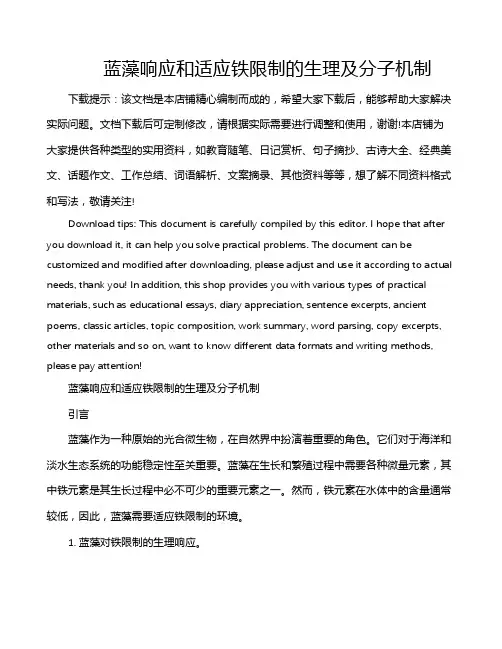
蓝藻响应和适应铁限制的生理及分子机制下载提示:该文档是本店铺精心编制而成的,希望大家下载后,能够帮助大家解决实际问题。
文档下载后可定制修改,请根据实际需要进行调整和使用,谢谢!本店铺为大家提供各种类型的实用资料,如教育随笔、日记赏析、句子摘抄、古诗大全、经典美文、话题作文、工作总结、词语解析、文案摘录、其他资料等等,想了解不同资料格式和写法,敬请关注!Download tips: This document is carefully compiled by this editor. I hope that after you download it, it can help you solve practical problems. The document can be customized and modified after downloading, please adjust and use it according to actual needs, thank you! In addition, this shop provides you with various types of practical materials, such as educational essays, diary appreciation, sentence excerpts, ancient poems, classic articles, topic composition, work summary, word parsing, copy excerpts, other materials and so on, want to know different data formats and writing methods, please pay attention!蓝藻响应和适应铁限制的生理及分子机制引言蓝藻作为一种原始的光合微生物,在自然界中扮演着重要的角色。
无人机RTK技术在蓝藻水华监测中的应用随着科技的进步,无人机技术在水资源监测领域得到越来越广泛的应用。
其中,无人机RTK技术已经成为了蓝藻水华监测的重要手段之一。
本文就具体探讨一下无人机RTK技术在蓝藻水华监测中的应用。
一、什么是无人机RTK技术?RTK全称为Real-Time Kinematic,即实时差分定位技术,是一种基于GPS或GNSS(全球卫星导航系统)的高精度测量方法。
无人机RTK技术是将这种技术应用于无人机上,通过将无人机与基站之间的距离和方向测量值实时传输至无人机,来实现在三维空间中高精度的定位结果。
因为基站的坐标已经事先测量出来,并且与全球卫星导航系统相连,因此无人机RTK技术可以实现相对于基站的毫米级精度。
1.快速高效的监测传统的蓝藻水华监测方法需要通过人工采集水样,再送至实验室进行化验分析,需要较长的时间。
而采用无人机RTK技术时,可以实现快速高效的监测,无需接触水体,也不会对水体造成污染,同时可在较短时间内获取水体中蓝藻的空间分布情况。
2.高精度的定位采用无人机RTK技术,无需通过人工设置控制点,可以直接利用控制基站的精确定位结果,实现无人机的高精度定位。
这样可以有效避免传统的蓝藻水华监测方法中由人工测量所带来的误差,从而提高监测结果的精度。
3.得到更加全面的监测数据传统的蓝藻水华监测方法中,只能获得局部区域的监测数据。
而采用无人机RTK技术,则可以在较短时间内获取较大范围内的监测数据,从而更加全面地了解水体蓝藻的分布情况。
三、需要注意的事项1.对于使用无人机RTK技术进行蓝藻水华监测的企业或个人,应当获得相关的监测资质和操作许可。
2.进行监测时应当注意无人机的安全飞行,并遵守相关规定,避免出现事故。
3.在使用无人机RTK技术进行蓝藻水华监测之前,应当仔细检查无人机和测量设备的状态,并进行相应的校准和测试。
4.为了确保得到高精度的监测结果,应当在监测前先进行对比测试,找出可能的误差来源,并进行相应的校正。
REVIEWHistidine kinase Hik33is an important participant in cold-signal transduction in cyanobacteriaNorio Murata a,*and Dmitry A.Los ba National Institute for Basic Biology,Myodaiji,Okazaki,444-8585,Japanb Institute of Plant Physiology,Russian Academy of Sciences,Botanicheskaya Street35,127276Moscow,RussiaCorrespondence*Corresponding author,e-mail:murata@nibb.ac.jpReceived5September2005;revised17 September2005doi:10.1111/j.1399-3054.2005.00608.x Acclimation of living organisms to cold stress begins with the perception and transduction of the cold signal.However,traditional methods failed to identify the sensors and transducers of cold stress.Therefore,we combined systematic mutagenesis of potential sensors and transducers with DNA microarray analysis in an attempt to identify these components in the cya-nobacterium Synechocystis sp.PCC6803.We identified histidine kinase Hik33as a potential cold sensor and found that Hik33participates in the regulation of the expression of more than60%of the cold-inducible genes. Further study revealed that Hik33is also involved in the perception of hyperosmotic stress and salt stress and transduction of the signals. Complexity of responses to cold and other environmental stresses is discussed.IntroductionDecreases in ambient temperature reduce enzymatic activities and ultimately depress various physiological activities.When the temperature changes suddenly and significantly,organisms often fail to survive.When such change is gradual,organisms can acclimate to their environment by sensing the shift in temperature and expressing large numbers of previously unexpressed genes,with resultant synthesis of specific proteins and metabolites that participate in protection against low temperature(Fig.1).Acclimation begins with the per-ception of the shift in temperature and transduction of the resultant anisms and/or individual cells appear to be equipped with sensors and signal transdu-cers that perceive and transduce cold signals.This review focuses on the initial events in cold-inducible gene expression,describing our analysis of potential sensors and transducers of cold stress in cyanobacteria (also reviews by Los and Murata2002,2004,and by Mikami and Murata2003).Unicellular cyanobacteria are particularly suitable for studies of stress responses at the molecular level.The general features of their plasma and thylakoid mem-branes resemble those of the chloroplasts of higher plants in terms of both lipid composition and assembly of membranes.Thus,cyanobacteria appear to provide powerful model systems for studies of the molecular mechanisms of acclimation to low temperature (Murata and Wada1995).Some strains of cyanobacteria,such as Synecho-cystis sp.PCC6803(hereafter,Synechocystis), Synechococcus sp.PCC7942and Synechococcus sp. PCC7002,are naturally competent,incorporating for-eign DNA that is efficiently integrated into theirAbbreviations–Hik,histidine kinase;Rre,response regulator.This paper is dedicated to Dr Marilyn Griffith,who passed away on February19th,2005,to recognize her outstanding contribution to research on cold stress in plants.Physiologia Plantarum126:17–27.2006CopyrightßPhysiologia Plantarum2006,ISSN0031-9317genomes by homologous recombination (Haselkorn 1991,Williams 1988).Therefore,many researchers have used cyanobacteria for the production of mutants with disrupted genes of interest (for review,see Vermaas 1998).The Synechocystis genome was sequenced in 1996(Kaneko et al.1996)with subsequent publication of the genome sequences of other cyanobacteria (see Murata and Suzuki 2005for a complete list with references).Genome sequences provide basic information that can be exploited for the genome-wide study of gene expres-sion.A commercially available genome-wide DNA microarray for analysis of gene expression in Synechocystis (Takara Bio Co.,Ohtu,Japan)covers 3079of the 3165(97%)genes on the chromosome of Synechocystis (99genes for transposases are excluded from this calculation).There are also 397genes on plasmids harboured by Synechocystis (Kaneko et al.2003).These genes are not included in the above-mentioned DNA microarray.Genome-wide analysis of cold-stress-inducible genes in SynechocystisWe used the DNA microarray from Takara to character-ize the genome-wide expression of genes in responseto environmental stresses,starting with cold stress (Suzuki et al.2001).The expression of a large number of genes was enhanced in response to cold stress,while that of another large number of genes was repressed.Some researchers have inferred that cold stress induces cellular dehydration that is essentially identical to that induced by hyperosmotic stress.To examine whether Synechocystis recognizes these kinds of stress similarly,we compared the effects of cold stress and hyperosmotic stress by DNA microarray analysis (Fig.2;Mikami et al.2002).These two kinds of stress enhanced,in common,the expression of genes for high light-inducible proteins (hliA,hliB,and hliC ),for rare lipoprotein A (rlpA ),for DNA mismatch repair protein (mutS ),for a sigma factor (sigD ),and for proteins with other functions.However,only cold stress enhanced the expression of the rbpA gene for an RNA-binding protein,the ndhD2gene for NADH dehydrogenase subunit 4,the crhR gene for an ATP-dependent RNA helicase,the fus gene for translation elongation factor EF-G,the feoB gene for ferrous iron transport protein,the infB gene for translation initiation factor IF-2,and various genes for proteins of known and unknown function.By contrast,only hyperosmotic stress enhanced the expression of genes for heat-shock proteins (hspA,dnaK2,groEL2,and clpB1),for the synthesis of glucosylglycerol (ggpS and glpD ),for the synthesis of lipids and lipoproteins (fabG and repA ),and for various other proteins (htrA,Cold stress SensormRNAs Proteins - enzymesMetabolitesgenes Signal transducerAcclimation to cold conditionsFig.1.A general scheme for the responses of a cyanobacterial cell to cold stress.rbpA, ndhD2, ndhF,crhR, rpl3, rpl4,fus, feoB, infB,ycf39, desB, nusG secE, folK, slr0082,slr0616, slr0236,slr1927, sll1611,sll0086hspA, clpB1, fabG htrA, spkHsigB, sodB, hik34htpG, dnaK2, dnaJ groES, groEL, groEL2ggpS, glpD gloA, repAsll0528, sll0846, slr1963slr0959, sll1884slr1603, slr1915slr0967, sll0939……4020513111hliA, hliB hliC, rlpA,mutS, sigD,slr1544, sll1541sll1862, sll1863sll1483HyperosmoticColdFig.2.Some cold-stress-inducible genes and hyperosmotic stress-inducible genes are the same,and some are different.The diagram includes genes that are induced during incubation of Synechocystis for 20min after a shift in growth temperature from 34 C to 22 C (cold stress)and after addition of sorbitol at 0.5M (hyperosmotic stress).Adapted,with permission,from Mikami et al.(2002)with inclusion of recent results from authors’laboratory.spkH,sodB,htpG,and gloA).Thus,cold and hypero-smotic stress each induced expression of a number of specific genes,while both stresses induced expression of a relatively small number of common genes(Fig.2), suggesting that Synechocystis recognizes cold stress and hyperosmotic stress as different signals via specific signal-transduction pathways.Two-component systems:positive regulation and negative regulationThe existence of two-component systems has been well-established in Escherichia coli and Bacillus subtilis (Aguilar et al.2001,Stock et al.2000).Each two-component system consists of a histidine kinase(Hik) and a cognate response regulator(Rre).The Hik per-ceives a change in the environment via its sensor domain,and then a conserved histidine residue within the Hik domain is autophosphorylated,with ATP pro-viding phosphate group(Stock et al.2000)that is trans-ferred from the Hik to a conserved aspartate residue in the receiver domain of the cognate Rre.Upon phos-phorylation,the conformation of the Rre changes, allowing the binding of the Rre to promoter regions of genes that are located downstream in the acclimation pathway(Koretke et al.2000).In E.coli and B.subtilis,the genes for each Hik and its cognate Rre are generally located close to one another on the chromosome.Moreover,these genes are often located near functionally related genes.Two-component systems are found also in cyanobac-teria(Mizuno et al.1996).However,genes for Hiks and Rres in Synechocystis are,in most cases,distributed somewhat randomly on the chromosome.Among the 44genes for Hiks,14are located near genes for poten-tially cognate Rres,whereas genes for the other30Hiks are located far from any rre genes.Thus,it is difficult to predict the pairs of Hiks and Rres that might function as individual two-component systems.Therefore,we sys-tematically mutated the genes for all the potential sen-sors and transducers of environmental signals and examined gene expression under various conditions using DNA microarrays.Synechocystis has3661putative genes,of which47 encode Hiks and45encode Rres(http://www.kazusa. or.jp/cyanobase/Synechocystis/index.html).There are 44genes for Hiks on the chromosome,which we named hik1through hik44.We deduced that three putative Hiks,namely,Hik11,Hik17,and Hik37, might be inactive as Hiks,because they lack the con-served histidine residue in the Hik domain.Hik32might also be inactive as a Hik,because the hik32(sll1473) gene is part of a larger gene,namely,sll1473-sll1475,which is interrupted by a transposon(sll1474)in the strain that was used for genome sequencing and sys-tematic mutagenesis(Okamoto et al.1999).The gene for the Hik encoded by pSYSM,a plasmid harboured by Synechocystis,was designated hik45,and the genes for Hiks encoded by pSYSX,another plasmid,were desig-nated hik46and hik47.There are42chromosomal genes for Rres and two and one on plasmids pSYSX and pSYSM,respectively.We designated the42chro-mosomal genes for rre1through rre42.The rre genes on pSYSM and pSYSX were designated rre43and rre44and 45,respectively.We inactivated each putative hik gene in Synechocystis by inserting a spectinomycin-resistance gene cassette to create a gene-knockout library(Suzuki et al.2000;CyanoMutants,http://www.kazusa.or.jp/ cyano/Synechocystis/mutants/).This library has proved to be a powerful tool for the identification of sensors of various stimuli and the corresponding signal transducers in Synechocystis(Marin et al.2003,Paithoonrangsarid et al.2004,Shoumskaya et al.2005,Suzuki et al.2000, Suzuki et al.2004,Yamaguchi et al.2002).We exam-ined the genome-wide expression of genes in wild-type cells and in each line of hik mutant cells with DNA microarrays in an attempt to identify the Hiks involved in the regulation of expression of stress-inducible genes. Regulation of gene expression in response to stress can be positive or negative(for details,see Murata and Suzuki2005).In positive regulation,a two-component system is inactive under non-stress conditions.Genes controlled by such systems are silent or expressed. When cells are exposed to the appropriate environmen-tal stress,the two-component system is activated(by phosphorylation in response to the stress),and then the activated system enhances the expression of genes that are silent under non-stress conditions or represses the expression of genes that are expressed under non-stress conditions(Murata and Suzuki2005).Most stress-inducible gene expression in Synechocystis is positively regulated.In negative regulation,the two-component system is active under non-stress conditions,and the expression of the genes controlled by such a system is either enhanced or repressed.Under appropriate environmen-tal stress,the two-component system becomes inactive. Genes that are expressed or repressed under non-stress conditions become silent or are released from repres-sion,respectively.Levels of expression of genes fall in the former case and rise in the latter.Changes in phenotype due to mutations in Hiks and Rres,which reflect the effects of such two-component systems on gene expression,differ between positive regulation and negative regulation.A knockoutmutation in either the Hik or the Rre in a two-compo-nent system for negative regulation has marked effects on gene expression.The expression of genes controlled by a negatively regulating two-component system is either enhanced or repressed under non-stress condi-tions.Therefore,a specific signal-transduction pathway with a specific Hik and a specific Rre can be identified with relative ease in cases of negative regulation.By contrast,a knockout mutation in a Hik or an Rre in a two-component system that operates via positive reg-ulation does not have a significant effect on gene expression under non-stress conditions.In such a sys-tem,the identification of the Hik and the Rre in a specific signal-transduction pathway requires the screening of knockout libraries of hik and rre genes under individual types of stress.Negative regulation of gene expression Using DNA microarray,we analyzed the effects of muta-tion of each hik gene on gene expression in mutant cells that had been grown under normal conditions.No sig-nificant alterations in gene expression were evident in most of the mutants.However,three mutants,D hik27, D hik34,and D hik20,each with a mutation in the indi-cated Hik,were unique,because,in these mutants,the expression of some genes was enhanced and that of some others was repressed,indicating that Hik27,Hik34,and Hik20might be involved in signal transduction via the negative regulation of gene expression.We compared gene expression in D hik27cells with that in wild-type cells under normal conditions (Yamaguchi et al.2002).Marked changes,with induc-tion factors higher than10,due to mutation of the hik27 gene(slr0640)were recognized only in the expression of three genes,namely,mntC,mntA,and mntB,which constitute the mntCAB operon that encodes subunits of the ABC-type Mn2þtransporter(Bartsevich and Pakrasi 1995,1996).Under normal growth conditions,Hik27 might transduce a signal that represses the expression of the mntCAB operon.Moreover,disappearance of this signal,due to inactivation of Hik27,might allow the expression of the mntCAB operon.This scenario corre-sponds to the scheme outlined for negative regulation. We examined the effects of mutation of various rre genes on gene expression in mutant cells.The mutation in D rre16cells enhanced the expression of only the mntC,mntA,and mntB genes.This phenomenon was very similar to the change in gene expression detected in the D hik27mutant.In its active form,Rre16might have repressed expression of the mntCAB operon.Then, inactivation of Rre16in D rre16-mutant cells eliminated the repressive effect of Rre16,allowing the expression of the mntCAB operon.These findings suggested that Hik27and Rre16might constitute a two-component system,acting as the sensor and signal transducer of Mn2þdeficiency.Ogawa et al.(2002)identified this two-component system independently by‘traditional’methods.Mutation of Hik34altered the genome-wide expres-sion of genes under normal conditions,namely,at a growth temperature of34 C(Suzuki et al.2005).In D Hik34cells,levels of transcripts of heat-shock genes, such as htpG,groES,and groEL1,were elevated,sug-gesting that Hik34might act as a negative regulator of the expression of these genes during normal growth. Because Hik34appeared to be a negative regulator of heat-shock-responsive genes,we postulated that its overexpression should result in repressed expression of these genes.We observed that the effect of overexpres-sion of hik34was the opposite of that of inactivation of hik34on the expression of heat-shock genes at the normal growth temperature(Suzuki et al.2005).This observation is consistent with the hypothesis that Hik34 is important in the regulation of expression of heat-shock genes.Positive regulation by Hik33in response to low temperatureMutation of the42other hik genes did not induces significant changes in gene expression.Therefore,it is likely that the Hiks encoded by these42genes regulate gene expression in a positive manner.To confirm this hypothesis,we screened our library of hik mutants under specific kinds of stress.To monitor the inducibility of the cold-inducible desB gene for the o3desaturase,we generated the pdesB::lux strain of Synechocystis,in which the promoter region of the desB gene was ligated to the coding region of the luxAB gene for a bacterial luciferase(Suzuki et al. 2000).Thus,we could use luciferase activity as an indicator of cold-inducible changes in the activity of the desB promoter.Then we inactivated separately the gene for each Hik in pdesB::lux cells by inserting a spectinomycin-resistance cartridge(Sp r),creating a gene-knockout library(Suzuki et al.2000).We screened the members of this library for loss of cold inducibility of gene expression by monitoring luciferase activity at a low temperature.Only pdesB::lux/D Hik33 and pdesB::lux/D Hik19,with disruption of the genes for Hik33and Hik19,respectively,exhibited reduced ability to activate luciferase at low temperature, suggesting that Hik33and Hik19might be involved in the perception and tranduction of cold signals.DNA microarray analysis of D hik33cells indicated that Hik33regulates the expression of 21of 36cold-inducible genes,with induction factors higher than 3.0(Fig.3;Suzuki et al.2001).These 21genes include ndhD2,hliA,hliB,hliC ,feoB ,crp ,and genes for pro-teins of unknown function.By contrast,15of the 36cold-inducible genes were not regulated by Hik33.Therefore,we can deduce that Synechocystis might have at least one other pathway for cold-signal trans-duction.DNA microarray analysis of the expression of genes in D hik19cells indicated that Hik19is unlikely to be a cold sensor.To identify the Rre that is located downstream of Hik33,we screened an Rre-knockout library by RNA slot-blot hybridization using some of the cold-inducible genes controlled by Hik33as probes.We identified Rre26as a candidate for the Rre that,with Hik33,con-stitutes a two-component system for cold-signal trans-duction (our unpublished results;Fig.3A).Tu et al.(2004)and Hsiao et al.(2004)postulated that Hik33might negatively regulate the expression of a set of photosynthetic and high light-responsive genes.Their hypothesis was based on changes in the global expres-sion of genes under normal conditions and the comple-mentation of the D hik33mutation in Synechocystis by the homologous nblS gene from Synechococcus with respect to the light-induced expression of hli genes,as monitored by Northern blotting.However,because the complementation test did not examine the genome-wide expression of genes,it is possible that their D Hik33mutant cells had,in addition to the mutation in hik33,a further mutation that might have produced changes in gene expression under normal conditions.To confirm our conclusion that Hik33is a positive regulator of signal transduction,we replaced the entire open-reading frame of the hik33gene with a spectino-mycin-resistance gene cassette that contained the O sequence,which is a strong terminator of transcription and inhibits the read-through of inserted genes on both sides of the cassette (our unpublished work).The growth rate of cells with deletion of hik33was similar to that of the wild-type and the insertion mutant of Hik33,contra-dicting the inferences made by Hsiao et al.(2004).DNA microarray analysis of the deletion mutant,comparing the pattern of gene expression with that of the insertion mutant under normal conditions,confirmed the absence of the major changes in gene expression reported by Hsiao et al.(2004).Our results suggest that the Hik33-dependent-signalling pathway involves the positive reg-ulation of gene expression.Responses to salt stress and hyperosmotic stressWe demonstrated previously that the perception of hyperosmotic stress involves Hik33and other unknown components (Mikami et al.2002).Later when we used the DNA microarray to investigate the impact of muta-tions in each Hik on changes in gene expression under salt stress (Marin et al.2003),we found that theCytoplasmic membrane?slr1927sll1611slr0955slr0236sll0494slr1436slr1974Hik33Rre26ndhD2hliA hliB hliC fus ycf39sigDslr1747ssr2016slr0400sll1911slr0401sll0815sll1770crhR rlpA rbpA cbiO cbiQ mutS desB slr0082feoB crtP slr1544sll1483sll1541sll0086slr0616Cold stressTotal: 21Total: 15AhtrAHik10??Hyperosmotic stressHik34Rre1sll0939slr0967Hik41Hik33fabG hliA hliB hliC gloA sigD sll1483slr1544ssr2016ssl3446sll1541rlpA repA glpD sll1863sll1862sll1772slr0581hspA clpB1sodB htpG dnak2spkH groES groEL1groEL2dnaJRre3Rre1Rre17Rre31sigB sll0528slr1119slr0852ssr3188sll0846slr1963slr0959sll1884slr1603slr1915ssl2971slr1413ssr1853slr0112sll0294slr0895slr1501sll0293sll0470Hik2Total: 11Total: 19Total: 5Total: 2Total: 1Total: 14Cytoplasmic membraneBHik16Fig.3.Hypothetical schemes showing the two-component systems that are involved in the transduction of cold stress and hyperosmotic stress,as well as the genes that are under the control of the individual two-component systems.Primary signals are represented by open arrows.Hiks are indicated as ellipses,Rres are indicated as hexagons,and selectively regulated genes are shown in boxes.Uncharacterized mechanisms are represented by question marks.Genes with induction factors higher than 3.0are included in these schemes.Minor discrepan-cies with respect to cold-inducible genes between this figure and Fig.2are due to the use of different versions of the DNA microarray in the respective experiments.(A)Cold stress;adapted originally from Suzuki et al.(2001)and Mikami et al.(2002),with inclusion of more recent results from authors’laboratory.(B)Hyperosmotic stress;adapted from Paithoonrangsarid et al.(2004)and Shoumskaya et al.(2005).inducibility of gene expression by elevated levels of NaCl was significantly affected in D Hik33-,D Hik34-, D Hik16-,and D Hik41-mutant cells.In each of these mutants,several genes were no longer induced by salt, or their inducibility by salt was markedly reduced. Because hyperosmotic stress and salt stress might affect some aspects of the physiology of cyanobacterial cells similarly,we examined whether these Hiks might also regulate gene expression under hyperosmotic stress.DNA microarray analysis demonstrated that they are indeed involved in hyperosmotic-signal trans-duction.Fig.3B shows that they regulate the expression of38of52hyperosmotic stress-inducible genes (Paithoonrangsarid et al.2004).Screening our Rre-knockout library by RNA slot-blot hybridization and with DNA microarray,we identified four Rres,namely,Rre31,Rre1,Rre3,and Rre17,that are involved in hyperosmotic signal transduction. Further analysis with microarray showed that four Hik-Rre systems,namely,Hik33-Rre31,Hik34-Rre1,Hik10-Rre3,and Hik16-Hik41-Rre17,as well as another sys-tem that included Rre1and possibly Hik2,appeared to be involved in the perception of hyperosmotic stress and transduction of the signal(Paithoonrangsarid et al. 2004).Fig.3B shows a hypothetical model of the hyper-osmotic signal-transducing systems that involve these Hiks and Rres,including the hyperosmotic stress-inducible genes that are controlled by the individual Hik-Rre systems.The Hik33-Rre31two-component system regulates the expression of11hyperosmotic stress-inducible genes.Inactivation of either Hik33or Rre31resulted in the elimination of or a marked reduction in the hyper-osmotic stress-inducible expression of these genes,indi-cating that Hik33and Rre31are tightly coupled in the signal-transduction pathway.The Hik10-Rre3two-component system regulates the hyperosmotic stress-inducible expression of only htrA,which encodes a serine protease.The Hik16-Hik41-Rre17system regulates the hyper-osmotic stress-inducible expression of sll0939and slr0967.Inactivation of Hik16,of Hik41,or of Rre17 eliminated the expression of these genes,suggesting that Hik16,Hik41,and Rre17are all essential for the per-ception of hyperosmotic stress and for transduction of the corresponding signal.Hik41probably acts down-stream of Hik16,because Hik41is a hybrid-type Hik that contains both a signal-receiver domain and a Hik domain,whereas Hik16is a typical Hik with a Hik domain and potential sensory domain that,hypotheti-cally,spans the membrane seven times.It is also possi-ble that Hik16and Hik41might perceive hyperosmotic stress as a complex.The Hik34-Rre1system regulates the expression of19 hyperosmotic stress-inducible genes(for heat-shock pro-teins and for proteins of unknown function).The Hik2-Rre1system regulates the expression of five genes that include the sigB gene for a sigma factor.Rre1might perceive hyperosmotic signals from both Hik34and Hik2.However,the regulated genes are specific to either His34or Hik2(Fig.3B;Paithoonrangsarid et al. 2004).DNA microarray analysis revealed that expression of 14of the52hyperosmotic stress-inducible genes was not controlled by any of the five Hiks and four Rres discussed above(Fig.3B).The signals,due to hyperos-motic stress,that induce the expression of these genes are probably perceived by unknown mechanisms that differ from typical Hik-Rre two-component systems. Such signals might act directly to regulate either tran-scription or the stability of the transcripts of these indu-cible genes.Using similar methods,we identified that five two-component systems are involved in the salt-stress signal-transduction pathway.To our surprise,they were iden-tical to those involved in response to hyperosmotic stress.However,the genes controlled by the individual pathways are different(Shoumskaya et al.2005),as discussed below.His33is a multifunctional regulatorAs described above,Hik33is involved in the perception and transduction of the cold signal and the hyperosmotic-stress signal(Fig.3).However,the cold-responsive genes controlled by Hik33are not identical to the hyperosmotic stress-responsive genes controlled by the same system.Fig.4shows that eight genes,including hliA,hliB,hliC,and sigD,are induced by both kinds of stress under the control of Hik33.However,Hik33reg-ulates the expression of eight other genes,including ndhD2,fus,crtP,and feoB,in response to cold stress specifically,and not to hyperosmotic stress,whereas it regulates the expression of three other genes,including fabG and gloA,in response to hyperosmotic stress spe-cifically,and not to cold stress.Thus,cold stress,hyper-osmotic stress,and salt stress are perceived as distinct signals by a sensory system that includes Hik33.In addition,recent studies(Hsiao et al.2004,Tu et al. 2004)suggest that Hik33might be involved in response to light stress.Moreover,a homolog of Hik33in Synechococcus is involved in sensing nutritional deficits (van Waasbergen et al.2002).Another level of compexity reflects the differential involvement of Rres in signal transduction and gene expression.Microarray analysis indicated that Rre26isinvolved in cold-signal tranduction (Fig.3A),whereas Rre31is involved in hyperosmotic-and salt-signal trans-duction (Fig.3B;Paithoonrangsarid et al.2004,Shoumskaya et al.2005).Moreover,eight genes respond,in common,to cold stress and hyperosmotic stress via Rre26and Rre31,respectively.Our observa-tions suggest that the mechanisms for perception of cold stress and hyperosmotic stress by Hik33are complex and that as-yet-unidentified components exist that pro-vide the sensory systems with their respective activities for induction of responses specific to each individual type of stress.Hik33perceives the cold signal via rigidification of membrane lipidsThe Hik33sensory kinase includes a type-P linker,a leucine zipper,and a PAS domain (Fig.5A;Los and Murata 1999,2002,2004,Mikami and Murata 2003).The type-P linker contains two helical regions in tandem that are assumed to transduce stress signals via intramo-lecular structural changes that result from interactions between the two helical regions and lead to intermole-cular dimerization of membrane proteins (Aravind et al.2003,Williams and Stewart 1999).In Hik33,cold stress might promote a conformational change in the type-P linker,with subsequent activation of Hik33via dimeriza-tion of the protein (Fig.5B;Los and Murata 2000,2004).There are two transmembrane domains in the amino-terminal region of Hik33(Los and Murata 2004,Mikami and Murata 2003).Because it has been suggested thatchanges in membrane fluidity might be involved in the sensing of temperature (Los and Murata 2000,Murata and Los 1997),it is likely that the transmembrane domains of Hik33can recognize changes in membrane fluidity at low temperatures (Los and Murata 1999,2000,2004).In 1996,we produced a series of mutants in which the extent of unsaturation of fatty acids is modified in a step-wise manner (Tasaka et al.1996).In one such mutant,the desA and desD genes for the D 12and D 6fatty acid desaturases,respectively,are inactive as a result of targeted mutagenesis.The desA –/desD –-double mutant synthesize only a saturated C16fatty acid and a mono-unsaturated C18fatty acid,regardless of growth temperature,whereas wild-type cells synthesize di-unsaturated and tri-unsaturated C18fatty acids in addi-tion to the mono-unsaturated C18fatty acid (Tasaka et al.1996).FTIR spectrometry revealed that the double mutation of the desA and desD genes rigidified the plasma membrane of Synechocystis at physiological temperatures (Szalontai et al.2000).ndhD2, fus, crtP, ycf39, feoB, slr1747, sll0086, slr0616fabG, gloA,ssl30448381121Cold; Hik33-Rre26Hyperosmotic;Hik33-Rre31hliA, hliB hliC, sigD slr1544ssr2016, sll1483sll1541Fig.4.A schematic representation of genes that are induced by cold stress and hyperosmotic stress under control of Hik33.The diagram includes genes that are induced during incubation for 20min after a shift in growth temperature from 34 C to 22 C (cold stress)and after addition of sorbitol at 0.5M (hyperosmotic stress).TM1TM2Type-PPAS His kinase 13248201217220270310350400600663ABType-P PASHis kinaseH HHLZ LZ Fig.5.A hypothetical scheme for the structure of Hik33.(A)Domain structure of Hik33.(B)A putative dimeric form of Hik33and its relation-ship to the cell membrane.A decrease in temperature rigidifies the membrane,leading to compression of the lipid bilayer,which forces the membrane-spanning domains closer changes the linker conforma-tion and finally causes dimerization and autophosphorylation of histi-dine kinase domains.TM1and TM2,Transmembrane domains;LZ,leucine zipper;Type-P,a type-P linker domain;and PAS,PAS domain that contains amino acid motifs P er,Arnt,S im,and phytochrome (Taylor and Zhulin,1999);H in circles,histidine residues that can be phosphorylated in response to cold stress.。